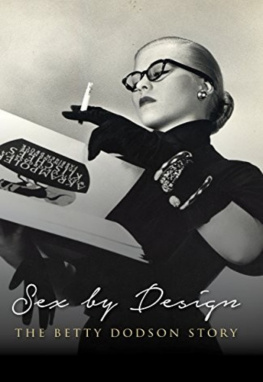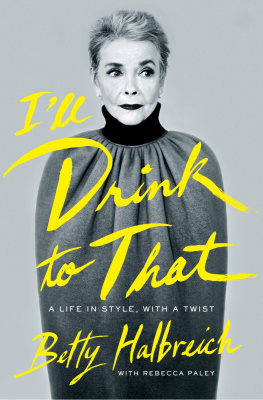Secrets of a
Fashion Therapist
What You Can Learn
Behind the
Dressing Room Door
BY BETTY HALBREICH
WITH SALLY WADYKA
ILLUSTRATIONS BY JEFFREY FULVIMARI
FOR ART DEPARTMENT

TO MY MOTHER, CAROL STOLL
one of the original tastemakers
Table of Contents
Chapter 1
GOING SHOPPING FOR THE TRUTH
Part
Betty was born to sail through peoples lives telling them what to wear (and even what to do). The other day I overheard her chatting with a client, Oh, shes been my friend for thirty-five years, and shes only thirty. Lines like that are good enough for George Cukor. The whole scenario is. Maybe shes known that all these years. Fashion is not only about necessity but also a form of entertainmentand that is what Betty sells.
Isaac Mizrahi, designer
W hen the snow was still up over my head in our hometown of Chicago, my mother would appear in a hat made of cherries. From the neck down shed be in her winter fur coat, but her head would be like a harbinger of spring. And in the fall, it was the same thing: Before the leaves had even begun to turn, out would come the first felt hat of the season, always with a feather. I remember getting in the car with her and watching her fight with that hatthe feather was so long she actually couldnt get it into the car! That was just her way of announcing the change of seasons. My mother was known all over town for her style and her witnot to mention her crazy hats. Of course, it would be hard not to be known around town when youre wearing flowers on your head in the middle of a Chicago snowstorm.
Thinking back, its little wonder I ended up where I am now. My fashion education started in her bedroom when I was just a little girl. Id sit mesmerized, watching her get dressed in sequined dresses, fox-trimmed suits, a cocktail dress with feathers lining the hem. One Christmas the photographer Victor Skrebneski gave my mother a white marabou jacket. Not many women could get away with wearing something so outrageous, but she wore that jacket to deathtrailing feathers all the way. My mother has the best taste of any human being Ive ever met, so who could blame me for trying to keep up? I think I started dressing up in my mothers clothes from the day I knew how to dress myself. The minute she left to go out for the evening, Id slip into her closet and drape myself with her most lavish velvet negliges, high heels, and dazzling jewelry.
As a child, I loved playing dress-up more than anything. And in a sense, thats what Im still doing today. Only now, instead of my mothers closet, I have all of Bergdorf Goodman to play withseven floors filled with designer collections, glamorous evening gowns, and unique accessories. And instead of just dressing myself (or my little dolls), I now outfit some of the most beautiful and famous women in the world. And just as I never got bored in my mothers closet, the daily challenges of dressing all sizes, shapes, and types of women still gives me a little thrill. When I find just the right dress for the mother of the bride, create a movie characters entire wardrobe, or calm a nervous young woman before her first job interview (while dressing her in a knock-em-dead new suit), I can shut my dressing room door at the end of the day and call it a success.
My mother always claimed that I walked to a different drummer when it came to dressing. Whatever my peers were doing, I deliberately went the other way. Even at summer camp, when we all had to wear a uniform, Id find a way to put my own stamp on it. I cuffed the shorts, rolled my sleeves a certain way, tied a sweater around my neck. Im not saying I always looked great. Maybe I even looked ridiculous at times, but that is exactly whats so much fun about fashion: taking a style risk here and there just to see what happens.
Sometimes it doesnt work at all, but then you know not to do it again, and eventually you build confidence in your ability to make smart fashion choices. Thats the real secret to dressing well: Its all about attitude. The attitude of the clothes, but also whats in your head. Its about walking into a room, knowing that you look and feel good, and projecting that attitude out to everyone who sees you.
When I first started my career as a fashion consultant in 1976, the phrase personal shopper didnt exist yet. But the customers were desperate for help. Bergdorf Goodman, which has always been New York Citys most chic department store, had just about everything anyone could possibly want, but the women who ventured through the revolving doors on Fifth Avenue were often intimidated, overwhelmed, or too frightened to try anything new.
Thats where I came in. From the beginning I think people came to me for reassurance and for an objective eye. When one of my customers puts something on, instead of looking in the mirror, she looks at me. I was born with a good eye, I admit. And its a blessing. I cant deny that there is something intuitive about dressing well and knowing what works and what doesnt. But that doesnt mean you cant learn to do it yourself. It just takes a little practice and a lot of looking in the mirror.
I have customers who have been coming to me since the day I first opened my dressing room door. Over the years, theyve brought in their friends, their mothers, their daughters, and even their granddaughters. When I first worked with Betty Buckley (who has been a customer for twenty years), she was on Broadway in Cats. And shes called me before every audition since then. By now, I think its almost a superstition. I find her an outfit, she gets the part. Some of my customers think I perform miracles. I think Im just honest. A woman who steps into my dressing room is more likely to hear Take it off, that looks awful than Oooh, thats fabulous!
I was being considered for a film based on a novel that I had tracked for three years. It was finally being produced by a great director and the cameo role I sought was really based on the look. I called Betty, we went right to Bergdorfs, and she found me the perfect suit. I walked into the directors office in my new Calvin Klein suit and the part was mine. Only last week I called her about another filmI told Betty over the telephone the character profileand she immediately sent me a couple of outfits, with shoes to match. Of course, I got the part. Betty is my Athena, and her art makes me feel like a goddess. Long may she reign!
Betty Buckley, actress
Most days my office bears more resemblance to a three-ring circus than it does to a chic fashion show. Theres a constant parade of women in all shapes and sizes: actresses, powerful executives, society types, housewives, young mothers, and regular working women. But regardless of who they are and how much they have to spend, in the end, they keep coming in because shopping and dressing is about much more than clothes. Its something you do to make yourself feel good. It should be fun. And sometimes even funny. Because if you arent enjoying your clothes, then you really are missing the point. I always maintain that no one walks into my officeor into any store anywhereunless she is ready for a bit of a change. I have yet to meet a woman who can walk past a store without her nose pressed to the glass. Shes desperate just to pass through. Show me a person who doesnt like new thingswhether it is a frivolous adornment or a necessityand I say she isnt a woman!
Part
Betty knows exactly what a clients wardrobe needs before the client even knows she needs it!
Next page












